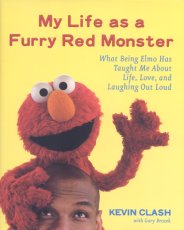 Excerpt
from My Life as a Furry Red Monster: What Being Elmo Has Taught Me About Life, Love, and Laughing Out Loud
Excerpt
from My Life as a Furry Red Monster: What Being Elmo Has Taught Me About Life, Love, and Laughing Out Loud
by Kevin Clash with Gary Brozek
1
Love
He may not look like it, but that Elmo's a love machine.
When parents tell me, "My child lives for Elmo," I tell them that Elmo lives because of their child's love for him. I don't just mean that Elmo is alive in their child's imagination, though that is certainly a part of it. That child and Elmo aren't just experiencing love; they're creating more of it to go around, and in doing so they make the world a better place.
It works like this: Elmo feeds off the love he receives from kids, from the adult characters on the show, and from his fellow Muppets. He doesn't just take that love in as a fuel and use it up. Instead, he drinks it in and gives it right back in spades. He's a kind of love-energy power station, and the more love he takes in, the more love he produces for the rest of the world. The more love he produces, the more love he receives, and the cycle completes itself over and over again. Talk about a renewable resource!
I first saw this powerful cycle in action shortly after Elmo debuted and was gaining in popularity in the mid-1980s, when I did an appearance with him at a school in the Bronx. A group of preschoolers were gathered in the library, all of them bundles of fidgeting energy with their legs swinging like metronomes. As soon as Elmo said, "Hello, everybody! Elmo loves you!" it was like a floodgate had opened, and Elmo and I were awash in a surge of little children. I could almost feel an electric charge in the room, as their shouts of "I love you, Elmo!" reverberated off the cinder-block walls. Elmo laughed and opened his arms wide and tried to scoop up all the love and hug it to his chest, all the while repeating "Elmo loves you, too."
That may have been the first time in my adult life when I finally comprehended the ancient notion that what you put out in the universe comes back to you. Since that day, I've learned to try to put as much Elmo and Kevin love out into the world as I can, knowing that it will have a very positive ripple effect. Elmo and the children taught me that one. Somewhere along the road to adulthood, we seem to forget this little secret about the power of love, but it's worth remembering.
When children tell Elmo that they love him, they all have different styles of expressing their emotion. Some of the more demonstrative kids throw their arms around his neck, snuggle their faces against his, and with an eyes-closed, sigh-heaving, hand-me-my-Tony-Award gesture that projects to the very last row of the theater's balcony, they proclaim their undying devotion to Elmo in prose as purple as Telly Monster. "Oh, Elmo, I love you more than chocolate ice cream! More than I love the new baby! Please come and live in my house forever!"
Older kids are a little more matter-of-fact, as if they've been married for twenty years and they're picking up their keys and their bag and heading out the door with an affectionate but perfunctory "Love you." Still others are more shy and reserved, like the bashful and nervous teen letting his or her feelings be known to their crush for the first time. I often wonder how these children will express their love as adults and how many of them will remain demonstrative and unembarrassed, or if they'll naturally pull back into more conservative styles as they grow older. It would be ridiculous if we all greeted each other the way the more enthusiastic kids greet Elmo -- imagine how long it would take to get that first cup of coffee at the office with all the morning greetings in full swing! -- but still, doesn't imagining a love-filled world like that put a smile on your face?
Children approach Elmo differently depending on their age, but they also are inevitably influenced by the kinds of physical demonstrations of affection they receive at home. Elmo wants to reach all kids, and sometimes he can be like that overly enthusiastic puppy who finds everything in the world so fresh and new and wonderful that he can't contain himself. Just as kids may squeal in delight when they first see a puppy and then retreat in leg-hugging, face-shielding fear when the puppy starts to jump on them, Elmo can evoke the same response. Over time, I've learned to think quickly on my feet, to gauge the kinds of responses I'm getting from a child and either tone down or amp up Elmo's enthusiasm level accordingly. I constantly have to remind myself that even though they've seen Elmo countless times on television, they're meeting him face-to-face for the very first time.
The funny thing is, no two kids are alike. I've seen the quiet ones respond with smiles and giggles that escalate to a full-on Elmo love attack -- the eardrum-piercing, vibrating, arms-wide, hugging and squeezing and kissing frontal assault. Other shy kids need a little bit of time to warm up to Elmo and his "de-monster-ative" displays of affection. But in the end, they all come around.
Excerpted from My Life as a Furry Red Monster by Kevin Clash with Gary Brozek Copyright © 2006 by Clash Puppets, Inc. Excerpted by permission of Broadway, a division of Random House, Inc. All rights reserved. No part of this excerpt may be reproduced or reprinted without permission in writing from the publisher.
